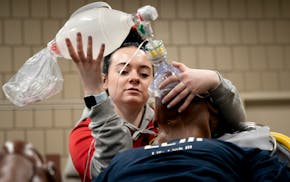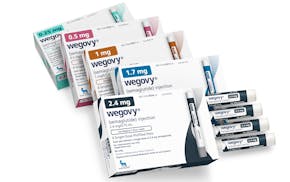Aggressive treatment of high blood pressure reduced deaths and complications such as heart attacks or strokes in a high-risk population of patients, according to a massive national study published Monday that likely will reshape how doctors manage a disease that affects millions of Americans.
The so-called SPRINT study monitored 9,300 patients, including recruits from the Minneapolis Veterans Medical Center, and compared those whose systolic blood pressure was kept at 140 or less to patients with more aggressive treatment whose systolic numbers were pushed to 120 or lower.
The rate of deaths was 27 percent lower and the rate of heart failure was 38 percent lower in the patients treated more aggressively. Minnesota specialists said that the findings are persuasive, due partly to the large population studied, and that they will influence how they discuss and approach treatment options with high-risk patients.
"There isn't going to be another study like this anytime soon," said Dr. Paul Drawz, who recruited patients to SPRINT in Cleveland before coming to the University of Minnesota three years ago. "If you're not going to change your practice based on this, you're going to wait a long time."
Just how many patients will be affected remains an open question. As many as 1 in 3 American adults have high blood pressure, or hypertension, whether they know it through screenings or not. A much smaller group, 17 million, would match the criteria of the high-risk patients in the study.
The findings contrast with the most recent national treatment guidelines, which generally recommend keeping systolic blood pressure (the top number in the common blood pressure measure) below 140 for patients 60 and younger and below 150 for older patients.
Study halted early
The results of the federally funded trial were so compelling that the study was halted early last fall after observing patients for an average of about three years.
The study excluded patients with diabetes and stroke and focused on those at risk because they were 75 or older, or because they were 50 or older and had known risks including a prior heart attack, smoking habit or cardiovascular intervention such as a stent placement. On average, patients in the "aggressive" treatment group took one additional medication.
Doctors assumed that more aggressive treatment made sense in this type of high-risk patient, but until now lacked the data to do so in the face of more lenient national guidelines, said Dr. Elizabeth Tuohy, a heart disease prevention specialist at United Heart & Vascular Clinic in St. Paul. "We don't have a lot of long-term outcomes yet," she said. "Over time, we'll have to see how this plays out. I personally will be treating patients more aggressively based on this data."
Doctors have long wrestled with how low blood pressure should go. Bringing it too far down, particularly in the elderly, can result in dizziness and fainting. According to the study results, about 5 percent of the patients, or 220 people, with the 120 blood pressure target had serious complications — blood pressure so low it caused severe dizziness or fainting or a reversible injury to the kidneys. Among those with the 140 target, 118 had serious complications.
A complication the investigators worried about with blood pressures of 120 or lower — an abrupt drop when people stood up — actually occurred more often in those with the higher systolic pressure target.
"When we put those complications in the context of a 27 percent reduction in total mortality, it seems that the benefits outweigh the risks," said David M. Reboussin, a biostatistician at Wake Forest Baptist Medical Center and a principal study investigator.
More aggressive treatment would raise doctors' obligations to monitor patients more frequently to make sure they are tolerating additional medication, said Drawz. "You can't just say, 'See you back in six months!' "
Drawz is conducting an ancillary study on 880 of the SPRINT patients, measuring their blood pressure at 27 months from the start of treatment. But while SPRINT monitored patients using in-clinic readings, Drawz's patients also used monitors that checked their blood pressure over the course of 24 hours and also when they were sleeping. He said there is evidence these are more accurate at assessing patients for complications. The U.S. Preventive Services Task Force recently updated its guidance on blood pressure screening to include 24-hour "ambulatory" monitoring to confirm in-office readings.
SPRINT results were released Monday at the American Heart Association meeting and in a paper published simultaneously in the New England Journal of Medicine.
The New York Times contributed to this report.
Jeremy Olson • 612-673-7744

Mahnomen hospital shutters inpatient beds to survive, a first in Minnesota

Hospitals too busy to train Minnesota paramedic students, exacerbating shortage

Minnesota pharmacies want permission, funding to administer vaccines

Showdown set between Minnesota and drug industry over rising costs

